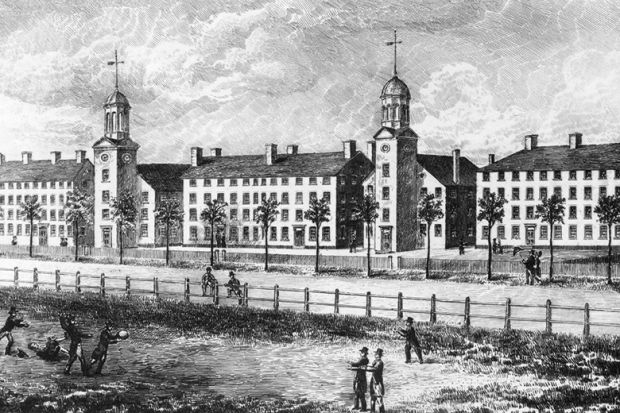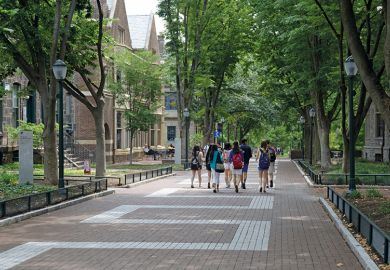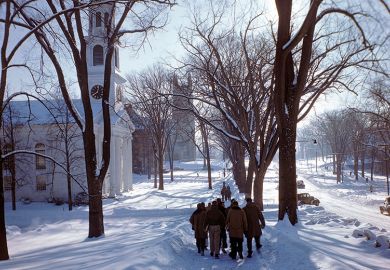Despite abundant scholarship in recent decades, teachers, students, policymakers and the general public still have an inadequate grasp of how culture, broadly conceived, has always shaped US higher education.
To address that problem, Paul Mattingly details what he calls seven broad “generational cultures”: evangelical, Jeffersonian, republican, industrial, progressively pragmatic, international and, what we have at present, corporate.
In the 18th century, for example, evangelical Christian beliefs were assumed to benefit US culture overall. This was not a problem when there were few colleges and few denominational rivalries. But whenever more denominations established their own colleges, what was believed to constitute the “social good” varied enormously and precluded any consensus. Mattingly uses 18th-century Congregationalist Yale College to exemplify first-generation collegiate culture.
By contrast, the second generational culture was exemplified by the Jeffersonian University of Virginia, which offered a non-denominational state university ethos.
The seventh and final generational culture incorporates the post-Second World War belief in “pragmatism”: the deployment of the intellect to solve virtually all major problems at home and abroad. This was epitomised by University of California System president Clark Kerr’s book, The Uses of the University (1963), in which academia had become “coincident with the dominant values of American society”. Western experts could effectively manage the world. David Halberstam’s The Best and the Brightest (1972), however, demonstrated the fallacy of such arrogance during the Vietnam War. It became painfully evident that empirical science within higher education did not “exhaust the approaches to trustworthy knowledge”.
As impressive as this book certainly is, especially if we consider all of Mattingly’s generational cultures, who seriously disagrees nowadays about the crucial impact of culture on US higher education? And who would dispute Mattingly’s basic stance that US higher education is not a story of “linear progress through time”? True, he properly credits Bernard Bailyn’s Education in the Forming of American Society (1960) and Lawrence Cremin’s The Wonderful World of Ellwood Patterson Cubberley (1965) for moving educational historiography away from treating all earlier developments and challenges as leading to the alleged greatness of the present. But this is old news.
Similarly, Mattingly’s introduction readily acknowledges the impact upon higher educational history from the 1970s of the so-called “new social history”, or the unprecedented attention given to class, race, gender and ethnicity. Institutions’ official administrative rhetoric, their admissions and hiring biases were subject to unprecedented scrutiny. But this is also old news.
To be sure, Mattingly characterises his study as synthesising earlier works. This clarifies the varying degrees of originality in his analyses and his heavy reliance on others’ writings. But he also succeeds in revising some persistent misconceptions about those US academic cultures.
Mattingly hopes that his work will be read, above all, by current and future college and university leaders who too often do not appreciate their institutions’ rich histories. I fully agree. Indeed, contrary to Mattingly himself, I see American Academic Cultures as far more than 15 “self-contained analyses”. Even if it includes much material that is commonplace to scholars in the field, it is a major contribution to the history of US higher education that amply repays readers’ investment of time.
Howard P. Segal is professor of history at the University of Maine. His edited history of the University of Maine from 1965 until 2015, Becoming Modern, is forthcoming.
American Academic Cultures: A History of Higher Education
By Paul H. Mattingly
University of Chicago Press, 464pp, £79.00 and £26.50
ISBN 9780226505121, 5268 and 5435 (e-book)
Published 10 January 2018
POSTSCRIPT:
Print headline: Shaped by faith and pragmatism
Register to continue
Why register?
- Registration is free and only takes a moment
- Once registered, you can read 3 articles a month
- Sign up for our newsletter
Subscribe
Or subscribe for unlimited access to:
- Unlimited access to news, views, insights & reviews
- Digital editions
- Digital access to THE’s university and college rankings analysis
Already registered or a current subscriber?







